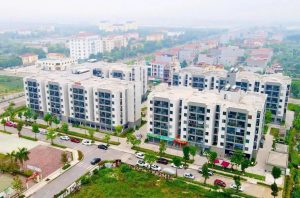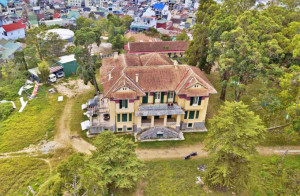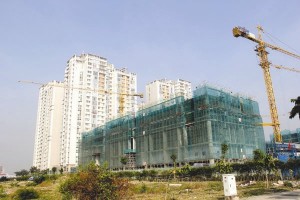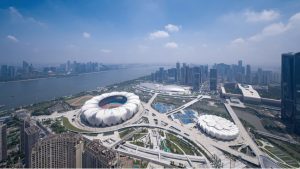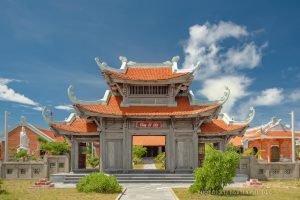Công bố quốc tế trong lĩnh vực kiến trúc, xây dựng (Tuần 4 tháng 8-2021)
Trong số này chúng tôi xin giới thiệu tới quý độc giả những nội dung chính của các công bố quốc tế đăng tải trên ScienceDirect và Springer Nature do Cục Thông tin khoa học và công nghệ quốc gia (NASATI) mua quyền truy cập như sau:
Quy hoạch đô thị:
– Sự phân bố không gian cung và cầu dịch vụ hệ sinh thái văn hóa ở các khu vực thành thị và ngoại ô: Một nghiên cứu điển hình từ Thượng Hải, Trung Quốc.
– Phân tích không gian về sự phối hợp giữa phát triển kinh tế, sử dụng tài nguyên và chất lượng môi trường trong tập hợp đô thị Bắc Kinh-Thiên Tân-Hà Bắc.
– Đánh giá chiến lược phát triển bền vững đô thị: Ứng dụng phân loại tính bền vững của dịch vụ thành phố thông minh.
– Ảnh hưởng của dòng chảy quá mức và mãn tính đến các hệ sinh thái rừng kết nối với khu vực thủ đô Tokyo.
– Đánh giá không gian về các đặc điểm thoát nước có lưu lượng cao và độ an toàn của đường bộ trong điều kiện ẩm ướt.
– Tạo chuyến đi, chuỗi chuyến đi và phát triển đa trung tâm ở đô thị Hoa Kỳ: Nghiên cứu điển hình về Vùng Wasatch Front, Utah.
– Không gian chung và “sự chung sống” trong cuộc sống sau này: Một nghiên cứu GIS định tính về người lớn tuổi không di cư và người nhập cư ở Singapore.
– Sự thúc đẩy của Úc để làm cho nhà ở dân cư bền vững – Người dùng cuối có quan tâm không?
– Đánh giá các lĩnh vực, cách tiếp cận, phương pháp và chỉ số trong tài liệu về vùng ven đô thị hóa.
– Việc sử dụng nước và thoát nước của các cảnh quan hỗn hợp, cận nhiệt đới thay đổi theo độ che phủ của cỏ và theo mùa.
Khoa học và công nghệ trong lĩnh vực kiến trúc, xây dựng:
– Hiệu suất cách âm và cách nhiệt của tấm composite nhựa nhiệt dẻo gia cường sợi bền vững để cách nhiệt trong các tòa nhà.
– Nâng cao hiệu suất của máy bơm nhiệt bằng cách nhúng thiết bị bên ngoài vào bể chứa nước ngầm.
– Tính chất chịu cắt của dầm BTCT được làm bằng bê tông cốt liệu tự nhiên, tái chế và cốt liệu nhựa đường tái chế trong điều kiện nhiệt độ bình thường và nhiệt độ cao.
– Khảo sát động đất của các công trình xây không có cốt thép có kích thước lỗ thông khác nhau: Nghiên cứu thực nghiệm và mô phỏng số.
– Hiệu suất của tấm sàn bê tông liên hợp bê tông cao su vụn khi uốn 4 điểm.
– Đánh giá hiệu suất của các biến được đo lường khác nhau từ hệ thống giám sát trên tàu để có được các mô hình sử dụng của các phòng trong một tòa nhà văn phòng.
– Tính chất cơ học và ứng dụng kỹ thuật của dầm liên hợp hai mặt nhịp thép – bê tông.
– Nghiên cứu kép kỹ thuật số trong ngành AECO-FM
– Mô hình đánh giá rủi ro sơ tán và mô phỏng dựa trên tác nhân tích hợp đối với cháy tòa nhà ngầm: Một nghiên cứu điển hình.
– Ảnh hưởng của tốc độ xâm nhập không khí đến giá trị truyền nhiệt của vỏ công trình.
Vật liệu xây dựng:
– Polyme có khả năng siêu hấp thụ để giảm mật độ khối của ván xi măng ép đùn.
– Ảnh hưởng của hình thái bề mặt cốt liệu thô đến cường độ bề mặt cốt liệu – vữa và các chỉ tiêu cơ học của bê tông.
– Cấu trúc lỗ rỗng và độ bền kéo đứt gãy của bê tông cốt sợi lai Bazan – Polypropylene chịu cacbonat hóa.
– Nghiên cứu so sánh về mô đun đàn hồi của cốt liệu tái chế tự nhiên và sau trận động đất trong các ứng dụng nền đường phụ có liên kết và không liên kết.
– Keo dán gỗ xi măng magie oxychloride mạnh qua hỗn hợp hữu cơ – vô cơ.
– Ứng dụng công nghệ nhận dạng hình ảnh dựa trên học sâu cho hỗn hợp bê tông nhựa: Phương pháp luận.
– Một phương pháp đơn giản để tạo vữa kỵ nước bằng cách sử dụng vi khuẩn được nuôi cấy trong môi trường lỏng.
– Hiệu suất của hai cảm biến ứng suất cải tiến được nhúng trong các mối nối vữa của các phần tử xây mới.
– Xi măng magie photphat gốc chất thải rắn: Cơ chế chuẩn bị, hiệu suất và hóa rắn/ổn định.
– Đánh giá đặc tính của bê tông tự lèn có bổ sung vật liệu gốc xi măng.
Xin trân trọng giới thiệu!
QUY HOẠCH ĐÔ THỊ
- Spatial distribution of cultural ecosystem services demand and supply in urban and suburban areas: A case study from Shanghai, China
Ecological Indicators, Volume 127, August 2021, 107720
Abstract
In the urban ecosystem, the demand for cultural ecosystem services (CES) has greatly increased, and the imbalance of CES supply and demand has been prominent. This paper integrated multi-source data to analyze and visualize the spatial differences in CES demand and supply capacity between Shanghai urban center and suburbs. Based on the geo-tagged photo data, the spatial distribution differences of the four types of CES demand, Recreation & tourism services (RTS) demand, Aesthetic services (AS) demand, Heritage & cultural services (HCS) demand, and Spiritual & religious services (SRS) demand, were analyzed. Residents and tourists had a strong demand for recreation and tourism, and the spatial agglomeration effect was the most obvious. Overall, CES demand was more concentrated in urban center, while the spatial distribution of suburbs was relatively discrete. At the same time, there were under supply areas of CES near the Huangpu River in urban center and suburbs. Results from bivariate Moran’s I method showed: 1) there was a significant positive spatial correlation between CES demand and CES supply capacity in urban center; 2) CES supply had a positive external impact on CES demand; and 3) the increase in CES supply capacity can promote the growth of CES demand.
- Spatiotemporal analysis of the coordination of economic development, resource utilization, and environmental quality in the Beijing-Tianjin-Hebei urban agglomeration
Ecological Indicators, Volume 127, August 2021, 107724
Abstract
Rapid urbanization has produced a series of environmental and resource issues in the Beijing-Tianjin-Hebei urban agglomeration (BTHUA). It is necessary to identify pathways toward sustainable urban development. This study explores the coordination relationship within the economy-resources-environment (ERE) system in the BTHUA during 2008–2017. First, a comprehensive indicator system and a coupling coordination index (CCI) were established to measure the coordination relationship in the ERE system. Second, an obstacle degree model was applied to identify the leading indicators affecting the coordinated development of the ERE system. Our results suggested that: (1) the coupling coordination state of the ERE system in the BTHUA has improved from a low coordination stage to a good coordination stage during the study period; (2) the spatial distribution of the coupling coordination state showed a pattern of better performance in the south and east and worse in the north and west; (3) the percentage of secondary industry in the GDP, percentage of built-up areas in the total land area, and sewage treatment rate were the primary factors that affected the ERE system’s coordination state. This study provides the basis for future work on the environment and resource protection in the capital region of China and other similar areas undergoing urban sprawl around the world.
- Assessing the urban sustainable development strategy: An application of a smart city services sustainability taxonomy
Ecological Indicators, Volume 127, August 2021, 107734
Abstract
This article contextualizes the smart cities paradigm in the panorama of contemporary city challenges, which increasingly encompasses the pursuit of sustainable development goals and the need to incorporate urban resilient behaviors, mainly in response to the impacts of climate change. Such a scenario also comprises the interpretation of smart cities as tools to assist policymakers and city administrators in directing solutions based on emerging information and communication technologies (ICTs) to the materialization of urban strategic plans addressing these confrontations. There are, however, no established indicator systems that attest to the substantiation of such plans by smart city solutions, nor to their alignment with the goals of urban sustainable development. Therefore, an analytical framework is proposed here to address this knowledge gap. It enables guiding the leverage of smart cities’ ICTs, not only for the achievement of economic goals, a feature intrinsic to smart city innovations, but also to reach other sustainability dimensions, as the environmental, social, institutional and cultural. To this end, generic sustainability indicator frameworks and also a set of smart city indicators are explored. They are examined as potential sources of specific taxonomies in smart city services for urban sustainable development. From this compilation of options, the Dashboard of Sustainability, once one of the indicator systems most recommended by experts, is revisited. It is adapted as a framework for analyzing and helping to maintain the strategic targeting of smart city solutions, during their entire lifecycle, at sustainability. To complete the qualitative-analytical-taxonomic frame, the services offered by a real smart city solution, the Rio de Janeiro Center of Operations, are employed as a model. This allows investigating its 9-year transition from a wider, larger capacity, strategic and innovative configuration in orientation towards sustainability perspectives, to a more narrow, operational composition, that is predominantly devoted to the economic dimension.
- Influence of chronic and excessive nitrogen influx on forest ecosystems connected to the Tokyo metropolitan area
Ecological Indicators, Volume 127, August 2021, 107771
Abstract
The impact of large cities on the environment is a concern not only on the environment of the urban area but also on the environment of the surrounding areas connected to the city and even the global environment. Therefore, it is necessary to determine the impact of large cities on the surrounding environment at various scales. Owing to human activities in megacities, various air pollutants are emitted into the atmosphere from fixed and mobile emission sources, causing severe air pollution problems. In particular, excessive anthropogenic nitrogen (N) emissions have become an urgent environmental issue that needs to be addressed globally. The impact of increased N emissions on a global scale also extends to forest ecosystems. The excessive N influx into forested areas alters the N dynamics of the ecosystem. To determine the impact of the Tokyo metropolitan area, one of the megacities in the world, on the surrounding environment, we investigated the influxes of N and sulfur (S) from bulk precipitation (BP) and throughfall (TF) at 12 forest sites surrounding the Tokyo metropolitan area. At the majority of the forest sites, atmospherically derived N and S influxes from TF were greater than those from BP. The N influx from TF in the forested area was equal to or greater than the amount of N deposited in the urban area. Air pollutants, mainly gases and aerosols, emitted from the Tokyo metropolitan area were transported to the inland forested areas by mesoscale meteorological and topographical factors. In addition, the forest canopy structure efficiently captured the dry deposition and accelerated the influx of N, particularly from the atmosphere into the forest ecosystems. The chronic and excess N influx due to human activities in the megacity has already resulted in high nitrate leaching at forested stream sites bordering the Tokyo metropolitan area.
- A spatial assessment of high-resolution drainage characteristics and roadway safety during wet conditions
Applied Geography, Volume 133, August 2021, 102477
Abstract
Much of the research regarding traffic crashes considers various geometric roadway features; however, ever-evolving urban watersheds and climate change increasingly impact roadway conditions. Little research has focused on the relationship between high-resolution drainage characteristics and the spatial distribution of crashes. This study incorporated local environmental and drainage risk factors in assessing network safety performance using spatial analysis techniques. Kernel density surfaces and the Local Getis Ord Gi* statistics were used to identify and visualize locations prone to experiencing crashes during wet conditions. Spatial regression modelling was used to link crashes to environmental and traffic risk factors across a citywide network. Proof-of-concept for this framework is demonstrated in the City of Philadelphia, Pennsylvania using publicly available spatial data. The results of this study show a relationship between local drainage, environmental characteristics, and wet crash distribution, providing novel insight into roadway safety during wet conditions.
- Trip generation, trip chains and polycentric development in metropolitan USA: A Case Study of the Wasatch Front Region, Utah
Applied Geography, Volume 133, August 2021, 102488
Abstract
Polycentric development is being promoted to lessen problems of urban sprawl and reduce vehicle miles traveled (VMT). This study examines polycentric development in the Wasatch Front Region (WFR), Utah, from a morphological perspective using employment data and a functional perspective by analyzing trip chain behavior. We find that morphologically, the WFR is more dispersed than centered but only has one functional urban center as the downtown Salt Lake City. Regarding trip chains, we find that although the automobile is the dominant travel mode outside urban centers, the trip chains by walking and biking are common in urban centers. Furthermore, we employed a multinomial logit model to examine travel behavior associated with urban centers. The results suggest that the WFR is still dominated by a single urban center, rather than being polycentric, reflecting the reality of many U.S. metropolitan regions. Our study suggests that job opportunities and amenities are critical to increasing functional polycentricity. Moreover, compact development, open space, and walkability encourage trip chain generation in urban centers. Last, improved public transportation facilities in the urban centers provide more options for commuting beyond the automobile and are necessary to increase the functional polycentricity of urban centers.
- Changes in urban land use throughout the Edwards Aquifer: A comparative analysis of Austin, San Antonio, and the Interstate–35 corridor
Applied Geography, Volume 133, August 2021, 102480
Abstract
Due to the vulnerability of the Edwards Aquifer to urban development, policy measures have been implemented to protect the important water resource in South–Central Texas. This paper analyzed land use change trends across different portions of the Edwards Aquifer to better understand the degree to which protective measures influenced aquifer urbanization rates. Specifically, the National Land Cover Database was used to quantify urban development within the contributing and recharge zones of the Edwards Aquifer across Bexar, Travis, Williamson, Comal, and Hays counties for three time periods: 2001–2006, 2006–2011, and 2011–2016. Bexar County exhibited the greatest reduction in the rate of urbanization within the recharge zone although the percentage of the zone developed remained the highest. Conversely, the pace of recharge zone development in Travis and Williamson County decreased less rapidly, but the percentage of the zone urbanized was lower. Limited urban development was observed across the aquifer in Comal and Hays County during the study period. Overall, the consistent declining rate of urbanization throughout the sensitive Edwards Aquifer recharge zone suggests that the policies protecting the aquifer were largely effective, particularly given the rapid pace of urban growth throughout the region.
- Beyond toilet decisions: Tracing sanitation journeys among women in informal housing in India
Geoforum, Volume 124, August 2021, Pages 10-19
Abstract
Urban political ecology shows how fractured power dynamics mutually shape urban built environments, formulating everyday negotiations around accessing needed sanitation infrastructure in the Global South. However, given critiques of the effectiveness of state health interventions to promote household toilet uptake and gender equity in sanitation, less attention has been paid to how or why urban poor women might gravitate towards a household toilet at all. I address this by drawing on mixed-methods and ethnographic fieldwork among women from two urban informal settlements in Maharashtra, India. My findings center on sanitation journeys, which I consider to be daily determinations around accessing different forms of sanitation infrastructure. I find that sanitation journeys go beyond what is usually considered a binary decision about “whether” to build a toilet to uncover an active, gendered timeline of connected events which may be sped up, slowed down, or reversed. Second, sanitation journeys occur within the space of tension between local residents of informal housing and municipal governing actors, thus elucidating ways in which the physical environment of sanitation relates to the social environment of gendered conflict, support, and competition. Lastly, a household toilet carries a dual role within these sanitation journeys; it is embedded within imaginaries of upward mobility and home-making, but is also complicated by the threat of eviction. In characterizing these trends and contradictions, I highlight how constrained choice behind sanitation journeys can illuminate ways women juggle the confluence of urban precarities amidst state efforts to change the sanitation environment.
- Shared spaces and “throwntogetherness” in later life: A qualitative GIS study of non-migrant and migrant older adults in Singapore
Geoforum, Volume 124, August 2021, Pages 132-143
Abstract
While there has been considerable academic interest in the topics of encounters and conviviality, including within the migration literature, little is known about how non-migrant and migrant older adults interact with one another in shared spaces, forming micro-publics that inflect the experiences of ageing for both groups. Using Qualitative Geographic Information Science (qualitative GIS), this paper identifies three types of spaces shared by non-migrant and migrant older adults from Singapore and the People’s Republic of China respectively. The first type of shared space is characterised by asynchronicity in that, despite co-located activities, intercultural interactions are less likely to be fostered between non-migrants and migrants. The second type of shared space features informal, spontaneous encounters that develop into more regular forms of interaction with ‘otherness’, but active negotiation of social difference could be limited. The third type of shared space is marked by formal, organised activities where non-migrants and migrants work towards a common goal, prompting productive negotiations with difference. Through juxtaposing these three types of shared spaces, we argue for the importance of drawing out how spatial attributes can deter or foster varying degrees of negotiations with difference, while acknowledging that the fluidity of such processes depend on the users and social contexts too. We also suggest that notions of ageing-in-place need to be analysed alongside ageing-across-borders, giving attention to how migration impacts ageing in later life—both for migrants who are adapting to life abroad temporarily as well as non-migrants who may experience “transnationalism by proxy”. (247 words; max 250 words)
- Australia’s push to make residential housing sustainable – Do end-users care?
Habitat International, Volume 114, August 2021, 102384
Abstract
The Australian construction industry is transitioning to becoming more sustainable. Despite their crucial role, Australian communities as the end-users of this transition have been overlooked. Buildings contribute as much as 30% of the total waste produced and as much as 40% of total greenhouse gases. Residential construction makes up the biggest sector in construction; about 80% by cost. If sustainable construction is to be realised, it must take root in the housing sector. Little progress, however, has been made. Current literature places much of the blame with the owners and occupiers of houses – The line goes that builders would build sustainable houses if people really wanted them. The question arises: are reported societal concerns for sustainability merely superficial or supported by intention and commitment to act. This study aimed to test public resolve for a transition to sustainable residential housing. Three focus groups, drawn from three diverse communities within the greater Melbourne metropolitan region, were engaged in describing and explaining community views on the desirability of sustainable housing. The unanimous consensus is that people want housing to be more sustainable, but that this is not forthcoming because of the intransigence of government and builders to facilitate a needed culture of change within the residential housing sector. This study contributes to the field, providing a model that encapsulates various dimensions of community’s, namely, end-users’ perceptions, based on the Theory of Planned Behaviour (TPB). Findings provide a sound basis for future researchers to address the challenges identified. The study also raises awareness of policymakers and industry practitioners of the genuine needs and requirements of end-users of residential buildings.
- A review of domains, approaches, methods and indicators in peri-urbanization literature
Habitat International, Volume 114, August 2021, 102387
Abstract
In the last decade, the peri-urbanization literature has attracted a lot of attention and many scholars have tried to examine these areas from different dimensions, leading to a comprehensive understanding of peri-urban areas. However, a review of domains, approaches, methods and indicators associated with peri-urbanization has received less attention. To this end, the current paper seeks to review them to fill out the gap in the field of researches related to peri-urban areas. The results reveal two thematic domains of peri-urban changes and peri-urban guidance. The methodological approaches were divided into three objective, subjective and pragmatic. Methods were analyzed under the subheadings of quantitative, qualitative and mixed and indicators were categorized in the form of procedural and substantive indicators. These categories form the methodological framework of peri-urbanization literature, leading to an increase in scientific awareness, understanding, supporting and validating of results.
- Wealthier-but-poorer: The complex sociology of homeownership at peripheral housing in Cartagena, Colombia
Habitat International, Volume 114, August 2021, 102388
Abstract
In the last two decades there has been a large and simultaneous expansion of delivery-based national housing programs in the global South. This paper draws on an investigation of living conditions in Ciudad del Bicentenario, a large-scale housing project on the outskirts of Cartagena. Based on a sample of seventy-five lengthy semistructured interviews with low-income residents and ten other stakeholders, we reached three paradoxical findings that reveal the high costs of free housing: the immediate improvement of overall quality of life but the impoverishment of economic prospects; the dual social condition of the residents who felt socially and economically isolated but also shared a widespread perception of being ‘revueltos’ or scrambled within the community of Ciudad del Bicentenario itself; and the growth of economic and physical informality in a project intended to counter the informal settlements in the inner city. These paradoxes reflect more than simple processes of impoverishment of living conditions: they demonstrate how this type of public policy systematically complexifies the daily life of relocated families. Sociologically, these findings reveal a new type of peri-urban poverty in the global South. We argue that the productive informalization of the formal housing projects constitutes a central, but previously understudied, aspect of what it means to develop equitable housing.
- Creating a makerspace in a characteristic town: The case of Dream Town in Hangzhou
Habitat International, Volume 114, August 2021, 102399
Abstract
The innovation system of a makerspace needs to be studied from the scalable perspective. Based on an analytical framework, this research examines the endogenous and regional factors that have shaped the innovation system of Dream Town, a government-cultivated makerspace in a characteristic town of Hangzhou, China. Employed a qualitative method, this research finds that Dream Town’s innovation system has been co-driven by the endogenous factors (i.e., innovation place, institution and policy, capital supports, and entrepreneurial service system) and the regional factors (i.e., human resources, university and research institutes, industrial structure, and entrepreneurial culture). This research advances our understanding of the factors behind innovation and the ways in which those factors interact to create makerspaces in the Chinese context.
- Water use and drainage of subtropical, mixed landscapes varies with turf coverage and season
City and Environment Interactions, Volume 11, August 2021, 100064
Abstract
We conducted a three-year drainage lysimeter study of mixed (woody plant-turf) landscape water demand relative to reference evapotranspiration, drainage, and plant growth in humid, subtropical central Florida. The aim was to develop information to guide more efficient water planning, landscape design, and irrigation management in a seasonally dry monsoon climate using three representative landscape species – southern magnolia (Magnolia virginiana), sweet viburnum (Viburnum odoratissimum), and St. Augustinegrass (Stenotaphrum secundatum) – at turf coverage of 90, 75, and 60% of the total landscape area. Water inputs (daily rainfall, irrigation) and drainage were recorded with a datalogger to calculate monthly actual evapotranspiration (ETA) for each lysimeter using a water balance approach. Growth was measured non-destructively (magnolia height, canopy and trunk diameter, viburnum dry mater, canopy cross section, and volume) every three weeks, while turf clippings were collected during the spring to late fall growing season. Woody plants imbedded in turf with ostensibly deeper root systems underlying turfgrass roots were more efficient at scavenging water, minimizing drainage, and leaching risk. Reducing turfgrass coverage to 60% diminished drainage by 70 cm in the wet season and 50 cm in the dry season compared to 90% turfgrass cover, and increased rainfall utilization rate to 0.81 compared to 0.40 for 90% turf across both seasons. Mixed turf-woody plant landscape ETA differed minimally across turf coverage treatments during the dry season, with approximately 70% of reference ETA versus 90% during the wet season, likely due to less surface evaporation. To conserve water and reduce drainage during the monsoonal dry season, mixed turf-woody plant landscape irrigation can be scheduled based on water demand at 70% of local evapotranspiration (0.7 Plant Factor). These results give water suppliers and landscape architects tools to design urban landscapes and develop regulations to efficiently promote and track mixed landscape irrigation water consumption in a monsoonal climate with a pronounced dry season. Further, water managers can reduce drainage and risk of groundwater pollution by encouraging design of landscapes with woody plants imbedded in turfgrass to scavenge water moving below the turfgrass root zone.
- Total area greenness is associated with lower per-capita medicare spending, but blue spaces are not
City and Environment Interactions, Volume 11, August 2021, 100063
Abstract
As evidence continues to mount that areas with more natural spaces also have healthier residents, researchers are beginning to suspect that these benefits extend beyond health to other related factors, such as healthcare spending. If more nature translates to better health, does more nature ultimately reduce the need for and spending on healthcare, and is this especially true for the elderly and disabled, who benefit differently from nature? This study aims to answer that question, employing a cross-sectional, ecological study design on county-level, annual per-capita Medicare spending in the United States. We examine the association between Medicare spending and the amount of total greenness in a county as well as the amount of blue space, or open water, in a county while controlling for demographic, socioeconomic, and healthcare access confounders. Our results show a significant and inverse association between greenness and spending and mixed results in regard to blue spaces and spending. The greenness-spending association persists in varying levels of the urban–rural spectrum, including both the most and least urban counties.
- Analyzing the correlation between visual space and residents’ psychology in Wuhan, China using street-view images and deep-learning technique
City and Environment Interactions, Volume 11, August 2021, 100069
Abstract
Although previous studies have assessed the relationships between visual space indicators and urban residents’ psychological perceptions, systematic research on the relationship between the urban visual space and residents’ psychological perceptions is still rare. The purpose of this study is to explore the correlation between the urban visual space and residents’ psychological perceptions, analyze the influence of visual space indicators on residents’ subjective perceptions, and focus on whether blue-green space is influenced by walkability, enclosure, openness, imageability, and traffic flow in the mechanism of its effect on urban residents’ psychology. In this study, the Fully Convolutional Network (FCN-8s) is used to segment the street view images of Wuhan. An urban perception data set is obtained by coupling the human-machine adversarial framework and the Random Forest algorithm. Based on the street view data, we design seven kinds of visual space indicators. We conduct multiple linear regression analysis on urban residents’ perceptions and the mediating effect analysis of blue-green space on residents’ psychology using the above five visual space indicators as mediator. The results show that there is a strong relationship between the urban visual space indicators and residents’ psychological perceptions, the visual space indicators such as greenness and enclosure have a strong influence on residents’ psychological perceptions and significant mediating effects of some visual space indicators occur in the process of blue-green space influencing residents’ psychology. This study comprehensively analyzes the relationship and mechanism between visual space indicators and residents’ psychological perception, and makes forward-looking work to further explore the complex mechanisms between visual space and residents’ psychology.
- Conceptualising a resilient cooling system: A socio-technical approach
City and Environment Interactions, Volume 11, August 2021, 100065
Abstract
Prolonged and/or extreme heat has become a natural hazard that presents a significant risk to humans and the buildings, technologies, and infrastructure on which they have previously relied on to provide cooling. This paper presents a conceptual model of a resilient cooling system centred on people, the socio-cultural-technical contexts they inhabit, and the risks posed by the temperature hazard. An integrative literature review process was used to undertake a critical and comprehensive evaluation of published research and grey literature with the objective of adding clarity and detail to the model. Two databases were used to identify risk management and natural hazard literature in multiple disciplines that represent subcomponents of community resilience (social, economic, institutional, infrastructure and environment systems). This review enabled us to characterise in more detail the nature of the temperature hazard, the functionality characteristics of a resilient cooling system, and key elements of the four subsystems: people, buildings, cooling technologies and energy infrastructure. Six key messages can be surmised from this review, providing a guide for future work in policy and practice.
KHOA HỌC VÀ CÔNG NGHỆ TRONG LĨNH VỰC KIẾN TRÚC, XÂY DỰNG
- Acoustic and thermal performance of sustainable fiber reinforced thermoplastic composite panels for insulation in buildings
Journal of Building Engineering, Volume 40, August 2021, 102747
Abstract
Acoustic and thermal insulation are major issues to be considered in buildings’ construction to meet the overall comfort conditions indoors and fulfill the energy-efficiency approaches. This work aimed to investigate the acoustic and thermal insulation performance of sustainable thermoplastic sandwich composite panels to be used in floor systems in buildings. Three types of recycled nonwoven fabrics were used in composites reinforcement; jute, polyester and hybrid jute-polyester (80:20%) with polypropylene as the matrix. Compression molding technique was used in manufacturing of the composite panels with different reinforcement and matrix ratios. The acoustic insulation performance of sandwich composite panels was evaluated in terms of impact sound attenuation test. As well the thermal conductivity was determined and the thermal insulation behavior was investigated using infrared thermography. The results indicated that all composite samples showed increased impact sound reduction at low frequencies. Jute and hybrid jute-polyester composites recorded a decrease in impact sounds reduction at high frequencies, whereas polyester composites showed fluctuated behavior. Increasing the reinforcement and matrix ratios enhanced impact sound reduction for jute composites at high frequencies, and for hybrid jute-polyester composites in the mid and high frequencies. The impact sound reduction index ΔLw values of all composites ranged between 12 and 21 dB. Furthermore, samples PJ and PT produced with 1-layer of reinforcement showed the lowest thermal conductivity and higher resistivity values compared to all samples. The polyester composites were the least samples to gain heat temperature after 60 min, and they exhibited the highest temperature difference compared to jute and hybrid jute-polyester composites.
- Seismic behaviour of frame structures with assembly of prefabricated concrete beam
Journal of Building Engineering, Volume 40, August 2021, 102765
Abstract
This study investigates a novel prefabricated concrete frame beam with an innovative assembly pattern that is cost-effective, reliable, practical, and has a good fault-tolerance. Quasi-static cyclic experiments were carried out on a cast-in-place (CIP) beam and three precast concrete (PC) beams with different lengths or widths of protruding beam stumps. The cracking propagation mode, load-bearing capacity, beam ductility, beam stiffness, and plastic energy dissipation ability were comparatively analysed. It is concluded that the hysteretic behaviour of the PC beams with the innovative assembly pattern suggested in this study was similar to that of the CIP. Moreover, PC beams with a wider protruding beam stump displayed better seismic performance. In particular, development curves of crack width with cyclic load were obtained, which showed that the cracks widened gradually as the number of load cycles increased, and the main crack width increased significantly around the peak load. A finite element model (ABAQUS) was established to further reveal the working mechanisms and conduct a parametric investigation of the PC beams. Parametric simulations indicated that a reasonable and relatively larger thickness of the U-shaped beam shell and higher post-pouring concrete strength are recommended for practical applications of the proposed novel prefabricated concrete frame beams.
- Enhancing the performance of heat pumps by immersing the external unit in underground water storage tanks
Journal of Building Engineering, Volume 40, August 2021, 102732
Abstract
Renewable energy sources have a considerable potential to contribute to sustainable development and have the potential to reduce the reliance on fossil fuels. Direct-Expansion Water Source Heat Pump (DX-WSHP) could be used in air conditioning applications as an energy-efficient environmental-friendly system. In this study, DX-WSHP potential for air conditioning of a multi-level residential building was numerically examined. A closed-loop of copper pipes filled with R134a, as a refrigerant, was immersed in an underground water tank that is used as a heat sink/source. Cooling/Heating loads of the residential unit under three different climate conditions were estimated at different floor levels. The proposed system takes advantage of a higher heat transfer rate in water and better thermal performance when compared with traditional Air Source Heat Pumps (ASHP). A mathematical model was built to examine the performance of the system using the Engineering Equations Solver (EES) software. Results have shown that the DX-WSHP has outperformed the ASHP at a lower (higher) condensing (evaporating) temperature in the cooling (heating) mode with higher values of COP varies from 30% to 118%. Furthermore, there was a significant reduction in economic and environmental impacts, CO2 emissions, and electrical energy consumption of the DX-WSHP system for the three different climate conditions. The reduction in CO2 emissions varied from 8% to 40%. Additional advantages of the proposed system were found: energy-saving and overcoming the problems concerning heat rejection to the surrounding air and the outdoor fan noise.
- Environmental evaluation of pump replacement period in water supply systems of buildings
Journal of Building Engineering, Volume 40, August 2021, 102750
Abstract
Cost analysis of facility replacement is the common method used in building services facility management nowadays, however, replacement evaluation from the environmental aspect still lacks in literature. This study is the first trial to introduce the environmental evaluation, life cycle assessment technique is adopted, into the replacement period justification of building services facilities, taking water supply pump in buildings as an example. An environmental evaluation model of water supply pump replacement is proposed in this study to minimize the total environmental impact (i.e. energy consumption) of the water supply system, which compares the extra operational energy expenditure in the long-term operation to the pump embodied energy. The literature review is used to obtain the energy intensity data, of mining, metal production, and metal casting, for the determination of pump embodied energy. The results demonstrate that for common pump motor ratings of 1.1–5 kW in water supply systems of buildings, with annual efficiency drop and pump energy intensity that ranges from 0.012 to 0.028 and 18.2–177.6 GJ/t iron and steel respectively, a longer pump replacement period is noticed at the greater energy intensity of pump (the maximum difference of the replacement period can be about 10 years). Besides, higher annual efficiency drop justifies a shorter pump replacement period. It was found that the replacement periods of smaller pumps are more sensitive to the pump energy intensity and annual efficiency drop. Moreover, it was also shown that for pumps with the maximum embodied energy intensity (i.e. 177.6 GJ/t iron and steel), for example, the pump material is stainless steel, the pump replacement periods evaluated on the environmental and economic grounds are comparable. The study results provide an alternative solution of pump replacement period for water supply systems in buildings based on the life cycle environmental assessment of water pump.
- Shear behaviour of RC beams made with natural, recycled aggregate concrete and reclaimed asphalt aggregates under normal and elevated temperature
Journal of Building Engineering, Volume 40, August 2021, 102681
Abstract
This paper experimentally investigate the structural performance of RC beams made with natural aggregate (NA), recycled aggregate concrete (RAC) and reclaimed asphalt pavement concrete (RAP) under normal and elevated temperature. The NA was replaced by RAC at two replacement ratios (20% and 40%). Also there was three mixes of 90%RAC-10%RAP, 80%RAC-20%RAP, and 60%RAC-40%RAP. Twelve reinforced concrete beams with a cross-section 150 mm wide, 250 mm high, and a length of 1200 mm were casted and tested. All beams were constructed without stirrups. Six RC beams were tested after exposed 400 °C. Shear strength, ultimate load and mid span deflection were measured. The experimental shear strength was compared to the analytical shear strength calculated using ACI-318-14 and Eurocode-2 formulations. The results showed that temperature has an adverse effect on the shear strength, load capacity, elastic stiffness and deflection of RC beams. Specimens made with RAP and RAC combination exhibited a significant loss in their load carrying capacity under elevated temperature while temperature effect was relatively less remarkable in specimens made with RAC and NA. Increasing RAP percentage in the concrete mix increased the loading carrying capacity of specimens significantly while increasing RAC percentage resulted in a decrease of their load carrying capacity. ACI and EC2 were highly conservative in predicting the shear strength of recycled aggregate.
- Investigation of earthquake behavior of unreinforced masonry buildings having different opening sizes: Experimental studies and numerical simulation
Journal of Building Engineering, Volume 40, August 2021, 102666
Abstract
In this study, three calcium silicate unreinforced masonry buildings were investigated via experimental studies and numerical simulation in order to determine their earthquake behavior. For building behavior, full-scale (1:1) masonry buildings, having different opening sizes, were subjected to cyclic loading. In each cycle, load and displacement values were recorded by computer setup and the occurred damage was marked on the building. It was observed that behavior of the building was linear until approximately 77% of maximum load and that there was no damage except for a few hairline cracks. Subsequent to this load level, change in the displacement value moved away from being linear and nonlinear behavior was observed at about 88% of the maximum load level. Hereafter, characteristic damage formation began and crack sizes increased. Torsional effect was also observed because of the stiffness difference due to the opening size in the walls. After maximum load level, it was determined that the building dissipated energy with opened-closed cracks and reached the collapsing limit at nearly a 1% story drift ratio. In the scope of numerical simulation, first masonry building was modeled with macro modeling using ANSYS software and the system was simulated by a similar load effect as the experimental study. The damage that occurred during the experimental studies was evaluated in terms of masonry building behavior and the numerical results were compared with the experimental results. The numerical simulation results were consistent with the experimental results until the maximum load level, but after this load level, the simulation results were not consistent with the experimental results.
- Performance of crumb rubber concrete composite-deck slabs in 4-point-bending
Journal of Building Engineering, Volume 40, August 2021, 102695
Abstract
A composite slab reinforced by profiled steel deck is a structural system where the longitudinal shear resistance between the steel deck and the concrete is the critical factor that governs the member capacity of the slabs under shear and/or flexural loads. Partially replacing concrete sand by crumbed rubber particles derived from used tyres to form crumb rubber concrete (CRC) can adversely affect the concrete mechanical characteristics; however, the plastic energy absorption and ductility of CRC have been shown to be improved. This paper presents an experimental study of large-scale composite slabs made of CRC or conventional concrete (CC) at similar compressive strength of 25 MPa that were tested under 4-point bending. Different shear spans and loading schemes were applied and tested in this study. The slabs were all 130 mm thick and had 3400 mm full span (800 mm shear span) for long slabs and 1800 mm full span (400 mm shear span) for short slabs. The overall performances, load carrying capacity, end-slippage, and interaction with steel of the tested CRC slabs were comparable or even better than those of the corresponding CC slabs, which indicated the viable substitution of CRC in composite slabs.
- Performance assessment of different measured variables from onboard monitoring system to obtain the occupancy patterns of rooms in an office building
Journal of Building Engineering, Volume 40, August 2021, 102676
Abstract
Considering the occupant behaviour as one of the most relevant matters that have an influence in the energy performance of buildings and also, one of the most relevant sources of the performance gap, the research work reported in this paper is focused on measuring the occupancy patterns as a variable that could contribute to overcome these problems. An in-depth work that analyses the suitability of different variables to obtain the occupancy patterns from measurements recorded by on-board monitoring systems is described. The indoor air temperature, the relative humidity, the CO2 concentration and the total electricity consumption measurements have been evaluated as occupancy indicators. The proposed approach has been applied to three rooms of an in-use office building. Said offices have different levels of occupancy and users with different habits. The study is based on selecting 32 months with four winters and four summers from a monitoring campaign from June 2013 to March 2019. The work schedule for the employees has been used as a reference to validate the results. This research demonstrates the capability to obtain occupancy patterns from measuring of the CO2 concentration and the total electricity consumption. The deviation between the occupancy patterns obtained from these variables and the reference schedule is under 10%, and it is lower for the rooms with larger occupancy rates. The proposed approach to obtain the occupancy patterns, together with new, smart and digitalised technologies, can contribute to catalyse the enhanced implementation of modelling techniques for building energy assessment and control.
- Evaluating thermal performance of vertical building envelopes: Case studies in a Canadian university campus
Journal of Building Engineering, Volume 40, August 2021, 102712
Abstract
Campus buildings at the University of Victoria (UVic) were largely constructed before the advent of building energy codes. The University is in the process of commissioning vertical building envelope upgrades/retrofits with added intention of addressing potential energy and greenhouse gas (GHG) savings in their building stock. The aim of this paper is to present the methodology adopted to evaluate potential energy savings from vertical envelope retrofits of 49 non-residential buildings across the campus portfolio, and to further validate those savings through more detailed energy models for a subset of buildings. To this end, the thermal performance of a building envelope was quantified based on its heat loss coefficient (UA), obtained from multiplying its surface area (A) by its thermal transmittance (U-value). Heat loss (UA) calculations were used as an energy loss metric to inform envelope rehabilitation prioritization, in addition to data gathered from building envelope condition assessments (BECAs). UA data were also analyzed against other building data such as floor area, vertical envelope area, vertical area to floor area ratio (VFAR), window-wall ratio (WWR), age, and type of construction for potential correlations. Finally, archetype energy models were used to evaluate the impacts of envelope retrofits on energy and GHG savings on three selected buildings. The outcomes of this study allow the University to weigh the benefits of improved energy performance from envelope retrofits against associated capital cost expenditures.
- Mechanical properties and engineering application of single-span steel-concrete double-sided composite beams
Journal of Building Engineering, Volume 40, August 2021, 102644
Abstract
This study investigates the mechanical properties of single-span steel-concrete double-sided composite beam, and describes the first practical application of this beam type in building structure. Four steel-concrete composite beams were tested with different parameters that govern the thickness and material strength of the bottom concrete slab. As a control, one ordinary composite beam without a bottom concrete slab was also tested for comparison. The failure mode, load carrying capacity, stiffness, interfacial slippage, internal force of the bottom concrete slab and cross sectional strain distribution are analyzed for all specimens. The results show that most of the damage occurred in the front section of the bottom concrete slab. The bearing capacity and stiffness of the double-sided composite beam are greatly improved compared to the ordinary composite beam. The stability of the lower steel beam flange in the negative moment region is also higher in the composite beams. Theoretical models of the bearing capacity for the various loading stages agree well with test results. The tests also show that interfacial slippage can be effectively mitigated through a full shear connection design. Additionally, to better improve the mechanical performance of the composite beams, the bottom concrete slab should be made with high strength materials or possess a large thickness. Finally, the first-ever practical application of the double-sided composite beam in a building structure is described in this paper.
- Digital Twin Research in the AECO-FM Industry
Journal of Building Engineering, Volume 40, August 2021, 102730
Abstract
The purpose of this paper is to examine and discuss the current patterns, gaps and trends in Digital Twin research in the architectural, engineering, construction, operation, and facility management (AECO-FM) industry and to propose future directions for industry stakeholders. A bibliometric search was performed on 197 papers that were obtained from the Scopus database. 151 of those papers were used in the subsequent scientometric analysis and mapping to narrate the evolution of the research subject. The studies discussed in the paper cover a wide range of research from model-based information management to building information management, all the way to the interaction between buildings and smart cities. The ‘virtual-physical building integration’, ‘building lifecycle management’, and ‘information integrated production’ subjects are highly in the focus of the research field. While ‘information-based predictive management’ and ‘virtual-based information utilization’ studies need to be addressed for a holistic Digital Twin adoption in the AECO-FM industry. Future studies should focus on the full integration of digital twin and its physical counterpart for better performance throughout the building life cycle. This study highlights the patterns, gaps and trends in Digital Twin research in the AECO-FM industry and contributes to the state-of-the-art digitalization and automation approaches in the construction project management body of knowledge. The sample size is a limitation for this research since it is relatively small due to the newness of the subject. Future studies may include data related to practice-oriented innovations and industry-initiated improvements to achieve broader and more informed results.
- Integrated agent-based simulation and evacuation risk-assessment model for underground building fire: A case study
Journal of Building Engineering, Volume 40, August 2021, 102609
Abstract
To reduce the casualties of underground shopping malls after a fire and provide a reference for better emergency decision-making, this paper undertakes an in-depth study of the fire evacuation risk in underground shopping malls. First, no theoretical model exists for selecting the fire source location of the existing building evacuation fire. Considering the approach-avoidance behavior of people toward fires during evacuation and assuming the worst-case scenario, the authors propose a multi-exit fire-source-location-selection model. This study then simulates an underground shopping-mall fire using Pyrosim software. Finally, this study improves the existing evacuation risk-assessment model based on previous research and studies on underground buildings using this new model. The model presents the evacuation risk distribution in various areas within the building clearly, providing references for both the fire protection design for underground shopping malls and forming fire-emergency plans. Moreover, the number of people in the building, pre-movement time, and safety exit widths significantly influence fire evacuation risk in underground shopping malls; specifically, the number of people in the building and the pre-movement time are positively correlated with the evacuation risk, whereas the width of safety exits is negatively correlated. The number of people inside the building has the greatest impact on the evacuation risk.
- Impact of air infiltration rate on the thermal transmittance value of building envelope
Journal of Building Engineering, Volume 40, August 2021, 102302
Abstract
Building envelope plays a crucial role in limiting the heat gains and affects the energy requirement for space cooling directly. To this end, building codes specify overall thermal transmittance values of the building envelope to address the building energy efficiency. However, these values do not consider the heat gains due to infiltration, which is a characteristic of the building envelope. With this context, the objective of this research is to measure the infiltration rates in apartments and propose an infiltration factor to revise the existing equation of the residential envelope transmittance value (RETV), recommended by the building code in India. Herein, the Blower door method is employed to measure the infiltration rates for a total of 20 air-conditioned apartments. Such a study, with the blower door method, has not been reported in India. The measurements show that the infiltration rates vary from 0.53 ACH to 1.63 ACH and are correlated with the window construction characteristics. Simulations are also carried out for estimating the impact of infiltration on the RETV with a calibrated energy model. The sensitivity analysis showed that the heat gain from infiltration accounted for 10%–33% of the overall envelope heat gains. The infiltration factor is derived for different climate zones of India by carrying out a parametric study involving 3072 simulation cases. It was found that 1 ACH of infiltration contributes 5.46, 4.22, and 3.53 W/m2 of RETV in hot-dry, composite and warm-humid climate respectively. A relationship between revised RETV and energy consumption is also established.
- An enhanced weather normalization method for identifying changes in the building condition
Journal of Building Engineering, Volume 40, August 2021, 102354
Abstract
Besides physical testing on buildings to detect the performance degradation of building components during Building Condition Assessments, energy consumption data should also be indicative of these defects. However, the methods to accurately analyze the changes in energy consumption over time have rarely been sufficiently evaluated. This paper compares the effectiveness of conventional weather normalization methods in deriving an accurate indication of the impacts on energy consumption from the changes in building condition. A proposed method based on the degree-days method is presented which aim to increase the accuracy of weather normalization by improving the representation of the energy-weather relationship through (1) excluding the energy consumption during the “shoulder seasons” from the dataset; and (2) applying a weighting exponent to the degree-days ratio. Multi-year building energy simulation was conducted to generate reference values of Typical Year energy consumption without influences from weather variation and the energy consumption affected by Heating, Ventilation, and Air Conditioning system degradation. Normalized annual space heating and cooling energy consumption data were compared to the reference values. Proposed method normalized values from the simulation study are within 2% Coefficient of Variance of the Root Mean Squared Error of the reference values, which is an improvement from the conventional degree-days ratio-based method by 59% for heating energy consumption and 9.7% for cooling energy consumption. Measured data of a case study were normalized to test the proposed method which confirmed minimal changes in energy consumption of the house over the years. The proposed method will be further evaluated when the data for more case studies with known building condition become available. This improved methodology can potentially be used to analyze how building condition degrades over time and its corresponding impacts on energy consumption, as well as to compare building condition across climate regions.
- Stability analysis of heavy machinery moving on weak subsoil. Analytical solution
Engineering Structures, Volume 241, 15 August 2021, 112152
Abstract
Theoretical formulation and analytical solution of the stability problem of heavy machinery, moving on caterpillar tracks on weak subsoil, is presented in the article. The machine base is treated as a perfectly rigid body. The machine-subsoil interaction problem, considering no-tension contact and elastic-plastic but simplified model of subsoil, is solved in a purely analytical way. The bearing capacity of layered subsoil is the most important entry data, used by the model. Different possibilities of its estimation are examined. Results of the analytic model are compared to those obtained from analogous 3D finite element (time-consuming) simulation done in the previous work of the Authors, showing qualitative and quantitative agreement. The interaction curves for the moments in two directions and weight of the machine are developed. Based on this algorithm of design a working platform for the given machine or assessing limit conditions for exploitation is proposed.
- Experimental and finite element analysis of flexural performance of RC beams retrofitted using near-surface mounted with CFRP composites and cement adhesive
Engineering Structures, Volume 241, 15 August 2021, 112429
Abstract
Fiber reinforced polymer (FRP) composite has been used effectively for the rehabilitation of concrete and steel structures in the last decades due to its excellent properties compared with conventional reinforcing materials such as steel. Despite the major role of epoxy resins as a bonding material between fibre and substrate, the rapid deterioration of the mechanical properties at elevated temperature is the critical issue for the epoxy matrix. Therefore, substitution of epoxy adhesive with cementitious bonding agent will be beneficial in order to provide more resistant systems at elevated temperatures. Near-surface mounted (NSM) strengthening technique with cement adhesives has only been investigated for torsion. Flexural performance is a significant factor in the strengthening of different structures. This paper reports the experimental study on the behavior of small scale retrofitted beams using Near-Surface Mounted strengthening system with carbon fiber reinforced polymer (CFRP) textile and laminate and cement-base adhesives for flexure. The beams retrofitted with modified cement-based adhesive achieved 98% to 100% ultimate loads of that beams strengthened with epoxy adhesives. Numerical analyses is utilized to evaluate the experimental results, and comparable results were observed between the experimental results and finite element analysis.
VẬT LIỆU XÂY DỰNG
- Superabsorbent ability polymer to reduce the bulk density of extruded cement boards
Journal of Building Engineering, Available online 14 August 2021, 103130
Abstract
The extrusion process has numerous advantages in the production of cement materials; however, cement extruded products over gain bulk density, adding costs to their fixation, workability, and application as structural reinforcement. The objective of this research was to develop and test extruded lightweight cement-based boards with the addition of superabsorbent polymer (SAP). A plain cement board containing 70% of cement and 30% of limestone filler was prepared. The different percentages of SAP from 0.0 to 2.0% based on cement mass did not interfere in the extrusion process. However, an expansion of the cement boards containing 1.0, 1.5, and 2.0% SAP occurred when passing through the extruder nozzle. The apparent porosity increased, and millimetric voids arose in the cement boards by increasing the SAP percentage. The apparent density of the cement boards favorably decreased from 8.6 to 28.4% by adding different percentages of SAP. However, the microstructural modifications raised the water absorption and substantially decreased the mechanical performance. Still, adding only 0.5% of SAP reduced the bulk density by about 10% without substantially decreasing the mechanical performance of the cement boards. Therefore, the SAP was very efficient in producing lightweight cement boards by extrusion.
- Effects of coarse aggregate surface morphology on aggregate-mortar interface strength and mechanical properties of concrete
Construction and Building Materials, Volume 294, 2 August 2021, 123515
Abstract
Coarse aggregate surface textures have a significant effect on mechanical properties of aggregate-mortar interface in normal strength concrete. The authors used a scanning microscope to scan the surface of aggregates in concrete to observe surface morphology. The results showed that the surface morphology components of coarse aggregates were varying at different scanning scales, which included waviness and roughness. Each component was quantitatively characterized. New methods to calculate the interfacial tensile strength and shear strength considering the influence of 3D surface morphology were proposed. The methods were introduced into a 3D meso-numerical model. Uniaxial compression and direct tension tests were conducted to examine the effects of coarse aggregate surface morphology (CASM) on the mechanical behaviors of concrete. Compared to the test results, the numerical model can well predict the failure procedure of concrete and the cracking characteristics of interface with different aggregate surface morphologies. Moreover, it was found that concrete tensile strength was more sensitive to CASM than compressive strength.
- Mechanical and energy performance of variably cured effective microorganisms cementitious composite designed via Taguchi
Journal of Cleaner Production, Volume 310, 10 August 2021, 127350
Abstract
Cement is a source of anthropogenic emissions ensuing environmental concerns and susceptible to crack under stresses. For mitigating the durability concerns, a bio-influenced effective microorganisms technology (EMs) has been employed in the cementitious composites. In the present research, the effect of EMs on the properties of self-compacting and conventional cementitious composites was explored using three types of EMs (EM1®, EMC® and EMX-Ceramics®) with three different of cements (CEMI, CEMIII and Calcium Aluminate cement). Taguchi approach of experimental design was implemented for optimization of formulations. L18 (21 × 37) orthogonal array was selected based on influencing factors namely w/c ratio, cement type, EMs type and EMs percentage replacement. Specimens were casted and cured in air, moisture and desiccator. Forensic inspections were performed to monitor the growth of hydration products and precipitation of bio-calcite precipitate. Energy performance of EMs modified composites was also analyzed using ECOTECT. Experimental results were analyzed statistically using analysis of variance (ANOVA). The analysis revealed that w/c and EM % replacements as the most governing parameters in response modification of cement composites. The 4% EM replacement was determined to be the optimal percentage in refining the fresh and hardened state response of cementitious systems. Forensics endorsed the microstructural refinements as a result of bio-precipitate, contributing in the increase of mechanical properties and reduction in 27% cooling loads. Moreover, theoretical equations were proposed for prediction and optimization of mix design based on Taguchi approach using extensive regressions.
- Pore structure and splitting tensile strength of hybrid Basalt–Polypropylene fiber reinforced concrete subjected to carbonation
Construction and Building Materials, Volume 297, 23 August 2021, 123779
Abstract
To investigate effect of carbonization on pore structure and splitting tensile strength, splitting tensile tests were subjected to normal concrete and basalt-polypropylene fiber hybrid concrete after carbonization at 0, 7, 14, 28, 56 and 80 days, respectively. The pore structure was examined using a Rapidair 457 concrete pore structure analyzer. The pore size was divided into three regimes, 0–40 µm, 40–140 µm, and 140–2000 µm. The macroscopic properties and pore structure of the concrete were analyzed, and the relations among the splitting tensile strength, fractal dimension and pore chord length frequency in three regimes of concrete were studied. Results show that hybrid basalt–polypropylene fiber reinforced concrete enhances the carbonization resistance of concrete. From the correlation analysis, it is deduced that the most sensitive pore size affecting the properties is 40–140 µm for normal concrete and 0–40 µm for hybrid basalt–polypropylene fiber reinforced concrete.
- Comparative study on resilient modulus of natural and post-quake recycled aggregates in bound and unbound pavement subbase applications
Construction and Building Materials, Volume 297, 23 August 2021, 123717
Abstract
The present paper deals with the potential employment of recycled debris in the field of road pavement engineering. In particular, the resilient behaviour of a recycled aggregate mixture produced from mixed post-quake debris is compared with that of a natural blend in both bound and unbound applications as road subbase layers. An experimental campaign based on cyclic load triaxial tests has been carried out to determine the resilient modulus of materials, which has been investigated after different periods and conditions of curing. Comparative analysis demonstrates that cement addition provides added value to recycled aggregates from mixed debris, whose resilient properties result comparable to those of virgin aggregates when employed in bound applications.
- Mechanical properties and failure mechanism of carbon nanotube concrete at high temperatures
Construction and Building Materials, Volume 297, 23 August 2021, 123782
Abstract
It is well documented that carbon nanotubes have better thermal stability compared with traditional polymer fibers, which enables application of carbon nanotubes to improve the performance of concrete at high temperature. In this work, the effects of carbon nanotubes on the compressive strength and microstructure of concrete at high temperatures are studied. The influence of temperature on the failure mechanism of carbon nanotube concrete is investigated. The experimental result shows that the carbon nanotubes inhibit further hydration reaction of the matrix at 300 ℃. The compressive strength of plain concrete increases more than carbon nanotube concrete at 300 ℃. The peak value of residual compressive strength migrates from 0.5% content of carbon nanotubes at room temperature to 0.3% content of carbon nanotubes at 600 ℃ and 900 ℃. A new failure mode of carbon nanotubes in concrete was observed at 600 ℃. A modified Matusinovic model is developed by introducing a function considering the influence of carbon nanotubes, predictions of the proposed model show reasonable accuracy compared with the experimental results.
- Analysis of relationship between component changes and performance degradation of Waste-Oil-Rejuvenated asphalt
Construction and Building Materials, Volume 297, 23 August 2021, 123777
Abstract
In this study, the underlying causes of the performance degradation of three typical waste-oil-rejuvenated asphalts (i.e., asphalts rejuvenated by waste cooking oil (WCO), waste bio-oil (WBO), and waste engine oil (WEO)) after secondary aging are explored via SARA fractions analysis. The rejuvenation provided by WCO is found to be mainly based on supplementing aged asphalt with saturates, which causes the newly formed colloids to easily lose light components and exhibit low stability. Further, WEO contains some metal residues that catalyze the oxidation and polycondensation process of asphalt. Consequently, the performance of the asphalts rejuvenated separately by WCO and WEO is severely degraded during aging. By contrast, WBO has a stable colloidal structure and lacks ashes; thus, WBO-rejuvenated asphalt exhibits the most stable and reasonable performance degradation in the aging process. Our research suggests that the effect of rejuvenation on aged asphalt cannot be judged only by the difference between the performances of the rejuvenated asphalt and the original asphalt. The performance maintenance of the rejuvenated asphalt during the secondary aging process requires further investigation.
- A strong magnesium oxychloride cement wood adhesive via organic–inorganic hybrid
Construction and Building Materials, Volume 297, 23 August 2021, 123776
Abstract
Developing high performance and non-toxic adhesives to replace the petroleum-based adhesives are highly desirable for wood industry. The use of magnesium oxychloride cement (MOC) inorganic adhesive is beneficial for the protection of human health and conservation of fossil resources. However, the low initial viscosity and poor water resistance have limited their application in plywood fabrication. In this study, polyacrylamide (PAM) and sodium polyacrylate (PAAS) were added to the adhesive as organic agents to construct wood-based composites by the organic–inorganic hybrid strategy. The MOC would be solidified by a cold-pressing method, forming a formaldehyde-free wood adhesive with high bonding performance. The addition of PAM efficiently improved the stability and processability of MOC, while PAAS improved the water resistance of MOC by inducing Mg2+ chelation and transforming the phase 5 structure. This adhesive exhibited a 53.5% increase in wet shear strength in contrast with the unmodified MOC adhesive. In addition, the MOC adhesive bonded wood-based composites showed high flame-retardant properties.
- Stress-dilatancy responses of recovered plastics and demolition waste blends as a construction material
Construction and Building Materials, Volume 297, 23 August 2021, 123762
Abstract
This research study focuses on the stress-dilatancy and compressibility responses of recovered plastics (RP) when used as a supplementary material in blends with construction and demolition (C&D) materials. RP is comprised of different types of waste plastics with a diverse range of shapes, colors, and sizes. The compressibility and collapse potential of RP/C&D blends were assessed through a series of one-dimensional consolidation tests. The stress-dilatancy responses and shear strength of RP/C&D blends were also evaluated via a series of monotonic drained triaxial tests. The RP content was the governing factor affecting the compressibility of blends with limited effect on the collapse potential of C&D aggregates. Moreover, the stiffness and strength of RP/C&D blends decreased with the increase in RP content. The inclusion of RP enhanced the energy absorption of the blends through the increase in total work input upon shearing. Stress-dilatancy properties of the RP/C&D blends were also found to be governed by the total work input parameter. The dilatancy of blends was also modeled within the scope of critical state soil mechanics with the use of dilatancy parameters correlated with the total work input.
- Application of deep learning-based image recognition technology to asphalt–aggregate mixtures: Methodology
Construction and Building Materials, Volume 297, 23 August 2021, 123770
Abstract
An important factor that affects the performance and durability of asphalt–aggregate mixtures is the size distribution of the aggregate particles. However, there are no accurate and quick methods of obtaining this information currently available. A potential solution to this problem is to use computer-aided image recognition technology, a technique that is being used increasingly more often in the field of pavement engineering. In this paper, asphalt core samples drilled from pavements are used as test objects. The information collected from the side surfaces of these cores is analyzed using neural network technology to help improve the speed and accuracy of the quantitative analysis of the asphalt mixtures. First, a camera is used to make a series of photographic images of the side surface and image reconstruction compositing is adopted to produce an image of the asphalt–aggregate mixtures. This image can be processed using a neural network (U-NET++) to identify the aggregate in the image. The training and recognition effect is improved by using Gaussian blur and secondary labeling methods. The grayscale images can then be binarized, filled, and the aggregate particles are segmented in order to identify holes and areas with adhesion problems. The geometric forms of the particles that appear on the side surfaces of the asphalt mixtures can be accurately obtained. Important geometric parameters (e.g. aspect ratio and roundness) can thus be derived from the image. A method of identifying and analyzing segregation and weakness in the asphalt mixture is proposed. The results show that our composite images are more accurate than traditionally-synthesized panoramic images. Also, the trained U-NET++ is ideal for recognizing and segmenting the aggregate image. The data obtained from the image can thus be used to quickly derive index parameters for the asphalt mixture. Compared with traditional test methods, this method only requires the use of mobile phones and personal computers. It is thus a lightweight and intelligent analysis method for acquiring information about asphalt–aggregate mixtures.
- A simple method to create hydrophobic mortar using bacteria grown in liquid cultures
Construction and Building Materials, Volume 297, 23 August 2021, 123744
Abstract
The ingress of water-soluble aggressive species is a major cause to the reduced service life of concrete structures. Bulk modification by adding hydrophobic agents in the cementitious materials is commonly applied to reduce water penetration into the concrete matrix. However, conventional hydrophobic modifications of concrete are associated with several unresolved major drawbacks such as high cost and toxicity. Here, we investigate the impact of safe and easy-to-culture bacteria on the hydrophobic properties of concrete. We demonstrate that hydrophobic concrete can be conveniently created by using the liquid culture of bacteria without the need of growing biofilms as suggested by previous research, even with a strain that does not present innate hydrophobicity. These key findings greatly improve the feasibility for the large-scale application of water resistance cementitious materials. Scanning electron microscopy and X-ray diffraction analyses indicated higher levels of micro-calcite formations with the increased addition of bacteria. These micro-calcite structures account for the dramatic increase in surface roughness which leads to elevated hydrophobic properties of the hybrid concrete. This phenomenon is reminiscent of the “lotus-leaf effect”, with ultrahydrophobicity arising from the nano- and microscopic topologies of surfaces. Bacteria-modified cement presents distinct heat-flow profiles during hydration consistent with the increased calcite formation. Taken together, this research gives unprecedented mechanistic insight into the design of microbial-modified concrete with hydrophobic properties particularly useful in floating and offshore structures. Given the large repertoire of bacteria still to be used, our work sets the stage for the future design of microbial-based hydrophobic concrete that can be tailored with additional functions such as self-healing and odor removal.
- Performance of two innovative stress sensors imbedded in mortar joints of new masonry elements
Construction and Building Materials, Volume 297, 23 August 2021, 123764
Abstract
Many historical cities enjoy the presence of masonry buildings with inestimable historical, artistic and cultural value. Old masonry buildings often suffer structural deficiencies, design faults and materials aging process. In recent years, many researchers focused their attention on the opportunities that structural health monitoring (SHM) can ensure for the health state of existing masonry structures, where damage can be difficult to be promptly predicted, pontentially causing abrupt collapses, with high risks for the community.
This paper presents an experimental study on the effectiveness of two types of stress sensor for SHM of new masonry elements. Ceramic piezoelectric sensors and capacitive sensors were installed in mortar joints of two series of specimens made of calcarenite stone masonry and clay brick masonry. All specimens were tested under uniaxial compression with displacement control, to assess the effectiveness of sensors in recording pressure variation within the different types of masonry and therefore testing their potential use for SHM applications. Even though both the ceramic and capacitive sensors were designed as stress sensors for concrete structures, their installation within mortar joints provided a good response, based on the comparison with standard measurement devices. Results demonstrate the suitability of the sensors even for SHM of masonry structures.
- Characteristic assessment of self-compacting concrete with supplementary cementitious materials
Construction and Building Materials, Volume 297, 23 August 2021, 123845
Abstract
This experimental study is paying attention to the fresh, mechanical, and durability performance of the self-compacting concrete containing fly ash and silica fume. Sixteen different sets of ternary blended self-compacting concrete of M30 grade are prepared as per Indian (IS: 10262-2019) [21] and European (EFNARC – 2005) [14] standards. To investigate the fresh properties (filling ability, flow ability, and segregation resistance), tests such as V- funnel test, V- funnel T5 minutes test, L- box test, slump flow test, and T500 mm slump flow time test were conducted. The compressive strength test, splitting tensile strength test, flexural strength test, and modulus of elasticity test were conducted to assess the mechanical properties of the SCC. Water absorption test, porosity, alkalinity test, acid resistance test, sulphate resistance test, salt-water resistance test and rapid chloride permeability test (RCPT) were conducted to evaluate the durability properties of the SCC. The results indicated that the fresh characteristics of ternary blended self-compacting concrete were gradually decreased when SCMs (fly ash and silica fume) replacement increases. The mechanical characteristics of ternary blended SCC were greater than that of the NSCC up to a certain limit of replacement. The durability properties of SCC were enhanced when replaced with SCMs.
- Solid waste-based magnesium phosphate cements: Preparation, performance and solidification/stabilization mechanism
Construction and Building Materials, Volume 297, 23 August 2021, 123761
Abstract
Magnesium phosphate cement (MPC) is a promising material for solid waste recycling. Other than undoped MPC studies, this review systematically summarizes 121 relevant literatures on the solid waste-based MPC published in the past 15 years. More than 40 types of solid waste-based MPCs are integrally evaluated. Besides, the hydration kinetics of MPC and action principle of doped elements are emphatically explored and discussed. Moreover, the gaps of solid waste-based MPC are analyzed from cost, performance, and safety. Finally, the future development trends of solid waste-based MPC, including life cycle assessment, long-term stability and priority of mechanism studies are investigated.
- A review on compatibility between crumb rubber and asphalt binder
Construction and Building Materials, Volume 297, 23 August 2021, 123820
Abstract
The compatibility between crumb rubber (CR) and asphalt binder plays a key role in the storage stability and rheological performance of rubberized asphalt binder. This review provides a comprehensive overview of characteristics of rubberized asphalt binder, factors influencing compatibility, compatibility evaluation methods, and improvement approaches. Desired compatibility results from the fact that CR is cross-linked with molecules of asphalt binder and evenly distributed in the asphalt binder, forming a homogeneous system. Rheological methods are the most widely used methods for compatibility evaluation. Additionally, the hybrid processing of surface activation treatment of CR and additives-grafting has shown to be a promising method for improving the compatibility of rubberized asphalt binder.
- Accurately predicting dynamic modulus of asphalt mixtures in low-temperature regions using hybrid artificial intelligence model
Construction and Building Materials, Volume 297, 23 August 2021, 123655
Abstract
The applicability of the widely used Witczak model was evaluated for the first time regarding the asphalt mixtures produced in the East part of China. 16 asphalt mixtures by 2 binders and 8 aggregate gradations were designed and the dynamic modulus testing was performed under various loading temperatures and frequencies. The results obtained are similar to previous studies from different countries (areas): the dynamic modulus of the asphalt mixture in the low-temperature region is overestimated. So then, a hybrid artificial intelligence algorithm to replace the traditional Witcazak model is implemented in this paper to correct the overestimation, using the same input parameters in the Witczak model. A modified beetle antennae search (BAS) algorithm was proposed in this study to improve the searching efficiency in the random forest (RF) model. The calculation process showed fast convergence and higher efficiency. The comparative results between the predicted and actual dynamic modulus showed higher prediction accuracy at all the temperature and frequency ranges, overcoming the weaknesses of the traditional Witczak model. The variable importance results showed that G* and phase angle of the binders have the greatest impact on the dynamic modulus. Volumetric properties also show certain influence ability, but the change of the variable controlling aggregate gradation has a weak influence on the dynamic modulus.
- Strength characteristics and microstructure evolution of cemented tailings backfill with rice straw ash as an alternative binder
Construction and Building Materials, Volume 297, 23 August 2021, 123780
Abstract
Cement is the most commonly used binder in mine filling materials, and it is a key to obtaining the desired mechanical properties of the backfill. However, cement costs often account for 75% of the total operational costs. The objective of this study was to use agricultural waste rice straw ash (RSA) to partially replace cement with a view to reducing the filling cost and yet improving the strength performance of cemented tailings backfill (CTB). The fluidity, strength characteristics, and microstructure evolution of CTB with different RSA replacement levels were measured through experiments. The results indicate the following: (1) The fluidity of the fresh CTB was reduced by the addition of RSA, but it could still ensure pipeline transportation. (2) The uniaxial compressive strength (UCS) of the CTB was positively correlated with the RSA replacement level. As the replacement level of RSA increased, compared to CTB without the RSA, the maximum increase of UCS of CTB with RSA was 46.2, 40.4, and 37.6% at 7, 14 and 28 d curing ages, respectively. (3) As the RSA replacement level increased, the strain in the compaction stage of stress–strain curve was decreased, and the elastic modulus of CTB with ARS was significantly improved. (4) The RSA consumed CH to generate additional C-S-H gel. The bonding strength within the tailings particles was enhanced, more compact microstructure was formed. Simultaneously, the micro aggregate filling effect of the RSA was conducive to further refinement of micro structure of CTB, thereby resulting in improvement of CTB strength. The research results have provided a theoretical and technical basis for the application of RSA in mine filling.
- Quantification of the actual expansion and deposition of rust in reinforced concrete
Construction and Building Materials, Volume 297, 23 August 2021, 123760
Abstract
The expansion of rust is often inhibited by the compression from concrete and the effects of the diffusion of rust, which obscure the actual amount of damage caused by the corrosion of the reinforcements. In this work, the relationship between the actual expansion and deposition of rust with a certain amount of corrosion is quantified by directly monitoring concrete displacement with digital image correlation (DIC) through accelerated corrosion testing. The actual expansion capacity of rust is thus evaluated through a new defined parameter called the “deposition coefficient of rust” by excluding the effects of the compression and diffusion of rust. A three-stage conceptual model is proposed accordingly to predict the deposition coefficient of rust throughout the corrosion process. It is found that the ratio between the expansion (displacement) of concrete caused by the rust layer and the depth of the corrosion or the thickness of the deposited layer of rust is almost a constant value before the initiation of concrete cracking, and then increases until reaching the maximum value. The findings from this work provide a new method to narrow the uncertainty of actual rust expansion which would cause concrete cracking.
- Fresh and hardened properties of brick aggregate concrete including coconut shell as a partial replacement of coarse aggregate
Construction and Building Materials, Volume 297, 23 August 2021, 123745
Abstract
The study was conducted to develop brick aggregate concrete including coconut shell as a partial replacement of coarse aggregate. Different coconut shell brick aggregate concretes (CSBACs) were prepared using 0–15% coconut shell aggregate (CSA) as a partial replacement of brick coarse aggregate and considering the water to cement (w/c) ratios of 0.45, 0.50 and 0.55 at the constant mix ratio of 1:1.5:3 (cement: fine aggregate: coarse aggregate) by bulk volume. CSBACs were tested to determine the major fresh and hardened properties. The fresh properties of CSBACs examined were workability and wet density. Among the hardened properties of CSBACs investigated, compressive strength was determined at the ages of 28, 56 and 90 days whereas splitting tensile strength, flexural strength, modulus of elasticity, Poisson’s ratio, and dry density were examined at the age of 28 days only. Test results revealed that the workability of CSBAC was lesser than that of the control concrete, but the decrease was lower with higher CSA content whereas the wet density of CSBAC decreased progressively with the increased amount of CSA. The compressive strength, splitting tensile strength, and flexural strength of CSBAC at 28 days decreased significantly for 10% and 15% CSA contents. However, at the ages of 56 and 90 days, the rate of gain in the compressive strength of CSBAC was higher for the w/c ratio of 0.50. The dry density and modulus of elasticity of CSBAC decreased with the increased amount of CSA for all replacement levels of brick aggregate whereas its Poisson’s ratio was higher than that of the control concrete at 28 days. Based on the data obtained, the correlations for the mechanical properties of CSBAC were sought. Strong correlations between most of the mechanical properties of CSBAC were observed in this study.
- Physicochemical, rheological and microstructural properties of Nano-Silica modified Bio-Asphalt
Construction and Building Materials, Volume 297, 23 August 2021, 123772
Abstract
For its renewability, environmentally friendly and cost-effective advantages, bio-oil is employed to partially substitute the petroleum-based asphalt. However, its usage weakens the high-temperature performance of petroleum asphalt. Therefore, hydrophobic nanosilica (NS) particles were employed as a physical modifier of crude palm oil (CPO) to improve the high-temperature performance of bio-asphalt. CPO with the addition of 0, 5, 10 and 15% (by weight) and NS with the addition of 0, 2, 4 and 6% were used to obtain the NS-modified bio-asphalts. The chemical reaction between NS and CPO was evaluated by employing the Fourier-transform infrared spectroscopy (FTIR). Penetration and softening point tests were conducted to ensure the consistency, while dynamic shear viscosity, temperature sweep test, multiple stress creep recovery (MSCR) were employed to evaluate the high-temperature rheological performance of the bio-asphalts and NS-modified bio-asphalts. Moreover, the chemical functional groups and morphological characteristics of the selected NS-modified bio-asphalts were investigated using FTIR and Field emission scanning electron microscope (FESEM) tests. Test results show that the consistency of the NS-modified bio-asphalts was improved by reducing penetration, and increasing the softening points and dynamic viscosity. The NS particles increased the rutting parameter (G*/sinδ) and reduced the aging sensitivity of bio-asphalt, while decreased its permanent strain and non-recoverable creep compliance (Jnr), and improved the percentage of the recovery. FTIR analysis showed a chemical reaction that occurred due to the addition of bio-oil and NS into asphalt. Apart from that, the FESEM exhibited that NS was uniformly dispersed in the base and bio-asphalts’ matrix. Therefore, NS effectively improved the high-temperature performance, aging resistance of the bio-asphalt.









